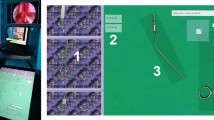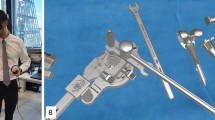Abstract
Objective
The current trend toward increasingly integrated technological support systems and the rise of streamlined processes in the OR have led to a growing demand for personnel with higher levels of training. Although simulation systems are widely used and accepted in surgical training, they are practically non-existent for perioperative nursing, especially scrub nursing. This paper describes and evaluates an interactive OR environment simulation to help train scrub nurses.
Methods
A system comprising multiple computers and monitors, including an interactive table and a touchscreen combined with a client–server software solution, was designed to simulate a scrub nurse’s workplace. The resulting demonstrator was evaluated under laboratory conditions with a multicenter interview study involving three participating ear, nose, and throat (ENT) departments in Germany and Switzerland.
Results
The participant group of 15 scrub nurses had an average of 12.8 years hands-on experience in the OR. A series of 22 questions was used to evaluate various aspects of the demonstrator system and its suitability for training novices.
Discussion
The system received very positive feedback. The participants stated that familiarization with instrument names and learning the instrument table setup were the two most important technical topics for beginners. They found the system useful for acquiring these skills as well as certain non-technical aspects.
Conclusions
Interactive training through simulation is a new approach for preparing novice scrub nurses for the challenges at the instrument table in the OR. It can also improve the lifelong training of perioperative personnel. The proposed system is currently unique in its kind. It can be used to train both technical and non-technical skills and, therefore, contributes to patient safety. Moreover, it is not dependent on a specific type of surgical intervention or medical discipline.





Similar content being viewed by others
Notes
German: Dipl. Fachfrau/-mann Operationstechnik.
German: technische(r) Operationsassistent(in) (TOA).
References
Cleary K, Kinsella A, Mun SK (2005) OR 2020 workshop report: operating room of the future. International Congress series, vol 1281, pp 832–838
Archer T, Macario A (2006) The drive for operating room efficiency will increase quality of patient care. Curr Opin Anesthesiol 19(2):171–176
Barbash GI, Glied SA (2010) New technology and health care costs—the case of robot-assisted surgery. N Engl J Med 363(8):701–704
Sutherland J, Van den Heuvel W (2006) Towards an intelligent hospital environment: adaptive workflow in the OR of the future. In: Proceedings of the 39th annual Hawaii international conference on system sciences, 2006. HICSS’06, vol 5, p 100b
Granger J, Hebb T, Lavallee R, Murray M (2011) Team training simulation in perioperative nursing education. Can Oper Room Nurs J 29(2):6–8, 10–11, 14 passim
Trice LB, Brandvold C, Bruno E (2007) Practice and education: partnering to address the perioperative nursing shortage. AORN J 86(2):259–264
Chang EM, Hancock KM, Johnson A, Daly J, Jackson D (2005) Role stress in nurses: review of related factors and strategies for moving forward. Nurs Health Sci 7(1):57–65
Sanford PG (2010) Simulation in nursing education: a review of the research. Qual Rep 15(4):1006–1011
Stahl JE, Egan MT, Goldman JM, Tenney D, Wiklund RA, Sandberg WS, Gazelle S, Rattner DW (2005) Introducing new technology into the operating room: measuring the impact on job performance and satisfaction. Surgery 137(5):518–526
Kneebone R (2005) Evaluating clinical simulations for learning procedural skills: a theory-based approach. Acad Med 80(6):549–553
Flurry M, Brooke S, Micholetti B, Natoli N, Moyer K, Mnich S, Potochny J (2012) Nurse training with simulation: an innovative approach to teach complex microsurgery patient care. Ann Plast Surg 69(4):459–461
Kenny A (2002) Online learning: enhancing nurse education? J Adv Nurs 38(2):127–135
Sutherland LM, Middleton PF, Anthony A, Hamdorf J, Cregan P, Scott D, Maddern GJ (2006) Surgical simulation: a systematic review. Ann Surg 243(3):291
Hanly EJ, Marohn MR, Bachman SL, Talamini MA, Hacker SO, Howard RS, Schenkman NS (2004) Multiservice laparoscopic surgical training using the da Vinci surgical system. Am J Surg 187(2):309–315
Lerner MA, Ayalew M, Peine WJ, Sundaram CP (2010) Does training on a virtual reality robotic simulator improve performance on the da Vinci surgical system? J Endourol 24(3):467–472
Sturm LP, Windsor JA, Cosman PH, Cregan P, Hewett PJ, Maddern GJ (2008) A systematic review of skills transfer after surgical simulation training. Ann Surg 248(2):166–179
Palter VN, Grantcharov TP (2010) Simulation in surgical education. CMAJ Can Med Assoc J 182(11):1191–1196
Aggarwal R, Undre S, Moorthy K, Vincent C, Darzi A (2004) The simulated operating theatre: comprehensive training for surgical teams. Qual Saf Health Care 13(suppl 1):i27–i32
Fort C, Fitzgerald B (2011) How simulation improves perioperative nursing. Nurse 2014 5(2):36–42
Sexton B, Marsch S, Helmreich R, Betzendoerfer D, Kocher T, Scheidegger D, TOMS team (1998) Participant evaluation of team oriented medical simulation. In: Henson LC, Lee AC (eds) Simulators in anesthesiology education. Springer, New York, pp 109–110
Grenvik A, Schaefer J (2004) From Resusci-Anne to Sim-Man: the evolution of simulators in medicine. Crit Care Med 32(2):S56–S57
Rauen CA (2004) Simulation as a teaching strategy for nursing education and orientation in cardiac surgery. Crit Care Nurse 24(3):46–51
Moorthy K, Munz Y, Forrest D, Pandey V, Undre S, Vincent C, Darzi A (2006) Surgical crisis management skills training and assessment: a stimulation-based approach to enhancing operating room performance. Ann Surg 244(1):139–147
Glaser B, Dänzer S, Neumuth T (2014) Intra-operative surgical instrument usage detection on a multi-sensor table. Int Comput Assist Radiol Surg 10(3):351–362
Glaser B, Koch L, Schellenberg T, Neumuth T (2014) Eye-tracking analysis of scrub nurse viewing behavior. In: Proceedings of the 5th workshop on modeling and monitoring of computer assisted interventions (M2CAI)
Mitchell L, Flin R (2008) Non-technical skills of the operating theatre scrub nurse: literature review. J Adv Nurs 63(1):15–24
Mitchell L, Flin R, Yule S, Mitchell J, Coutts K, Youngson G (2011) Thinking ahead of the surgeon. An interview study to identify scrub nurses’ non-technical skills. Int J Nurs Stud 48(7):818–828
\(\text{ Microsoft }^{\textregistered }\,\text{ Surface }^{\textregistered }\) 2.0 SDK and Runtime (updated 2 Feb 2012). http://www.microsoft.com/en-us/download/details.aspx?id=26716. Accessed 09 Apr 2015
Glaser B, Schellenberg T, Koch L, Hofer M, Modemann S, Dubach P, Neumuth T (2015) Not these scissors, the other scissors. A multi-center study comparing surgical instrument descriptions used by scrub nurses. In: Proceedings of iOR15: 1st international workshop on intelligent operating rooms, 17th international conference on E-health networking, application and services (IEEE Healthcom 2015), Boston, pp 21–25
Stammberger H, Posawetz W (1990) Functional endoscopic sinus surgery—concept, indications and results of the Messerklinger technique. Eur Arch Otorhinolaryngol 247(2):63–76
Acknowledgments
The authors would like to thank the following people for their kind support and dedication. From the Acqua Klinik and the International Reference and Development Center (IRDC) in Leipzig (Germany): Gero Strauß, Iris Gollnick, and Anja Rothe. From the ENT department at Leipzig University Hospital (Germany): Andreas Dietz and Markus Pirlich. From the Department of Otorhinolaryngology, Head and Neck Surgery, Inselspital, University Hospital of Bern (Switzerland): Marco Caversaccio, Bernd Werle, and Nexhmedin Avdija. From the Institute for Medical Informatics, Statistics and Epidemiology (IMISE) in Leipzig (Germany): Kais Tahar. From the Central Sterilization Department at the University Medical Center of Leipzig (Germany): Kerstin Schröter and her team. From the Innovation Center Computer Assisted Surgery (ICCAS) in Leipzig (Germany): Alexander Oeser, Klemens Birnbaum, Mario Cypko, Christoph Zeumer, Jens Meier, Stefan Franke, Max Rockstroh, Michael Unger, and Richard Bieck. ICCAS is funded by the German Federal Ministry of Education and Research (BMBF), the Saxon Ministry of Science and Fine Arts (SMWK) in the Unternehmen Region with grant number 03Z1LN12, the European Regional Development Fund (ERDF), and the government of Saxony under measures to support the technology sector.
Author information
Authors and Affiliations
Corresponding author
Ethics declarations
Conflict of interest
The authors declare that they have no conflict of interest.
Ethical standards
This article does not contain patient data.
Rights and permissions
About this article
Cite this article
Glaser, B., Schellenberg, T., Koch, L. et al. Design and evaluation of an interactive training system for scrub nurses. Int J CARS 11, 1527–1536 (2016). https://doi.org/10.1007/s11548-016-1356-9
Received:
Accepted:
Published:
Issue Date:
DOI: https://doi.org/10.1007/s11548-016-1356-9




